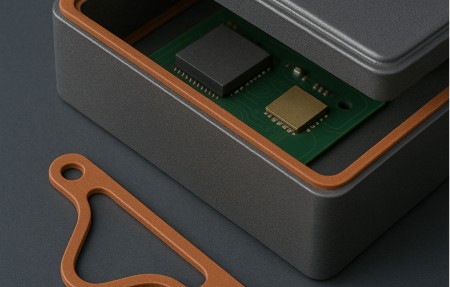Electromagnetic compatibility (EMC) is critical in high-reliability military and aerospace systems, where electromagnetic interference (EMI) can compromise mission success, system security, and human safety. While many engineers focus on shielding effectiveness in the lab, real-world field reliability requires deeper material insight: chemical resistance, galvanic compatibility, environmental ruggedness, and compliance with stringent military standards.
At Matrix Technology, we support engineers from design to deployment with precision-fabricated EMI shielding gaskets using Parker Chomerics conductive elastomers. This article explores advanced material selection strategies, galvanic corrosion prevention, and environmental durability—backed by MIL-DTL-83528 and proven in combat-ready systems.
Conductive Elastomer Material Selection: Balancing Shielding, Cost, and Compliance
Choosing the right conductive elastomer is more than just picking the highest shielding effectiveness. Engineers must evaluate the operating environment, base housing materials, fuel and chemical exposure, mechanical constraints, and electrical grounding integrity.
Material Classes and Their Use Cases
| Material | Binder | Key Strengths | Applications |
|---|---|---|---|
| CHO-SEAL 1215 | Silicone | Silver-Aluminum filler; MIL-DTL-83528 Type M | Aluminum avionics and UAV enclosures |
| CHO-SEAL 1298 | Silicone | Nickel-Graphite; robust EMI shielding at lower cost | Secure comms, defense enclosures |
| CHO-SEAL 1285 | Fluorosilicone | Silver-Copper; fuel and solvent resistant | Engine control systems, missile electronics |
| CHO-SEAL 6502/6503 | Silicone/Fluorosilicone | Custom molded/extruded profiles | Vehicle and airframe electronics |
| CHO-SEAL S6305 | UL 94 V-0 rated | Flame retardant, suitable for commercial aerospace | Cockpit displays, interior avionics |
UL 94 V-0 flame-rated elastomers, including CHO-SEAL 1273, 1310, and S6305, are critical for aerospace interior cabin compliance.
Galvanic Compatibility: The Hidden Risk in EMI Gasket Failure
When a conductive elastomer gasket mates with a metallic enclosure, galvanic corrosion can degrade shielding performance over time. This is especially problematic in environments with humidity, salt spray, or fuel exposure.
Material Pairing Strategies
- For aluminum housings, choose silver-aluminum-filled elastomers like CHO-SEAL 1215.
- For plated steel or mixed alloys, use nickel-graphite fillers (CHO-SEAL 1298).
- When exposed to fuels or solvents, select fluorosilicone binders like CHO-SEAL 1285 or 1287.
- Consult galvanic compatibility charts and aim for <0.25V potential difference between gasket and housing materials.
Matrix Technology offers galvanic compatibility guidance with FEA modeling support and corrosion resistance data to prevent long-term degradation in combat and aerospace environments.
Environmental Testing: Ruggedizing for the Real World
Engineers working on military-grade systems must ensure EMI gaskets survive thermal cycling, salt fog, vibration, and chemical exposure.
According to Parker Chomerics test protocols:
- Gaskets must retain electrical conductivity and shielding effectiveness after 168 hours in 5% salt fog spray.
- Performance must remain stable through thermal shock testing (–65°C to +160°C).
- Elastomers undergo ASTM B117 corrosion testing, MIL-STD-810 vibration, and long-term compression set analysis.
Some elastomers, like CHO-SEAL 6503 (fluorosilicone), are specifically formulated to survive jet fuel, hydraulic fluids, and lubricants without degradation.
Lab test data shows CHO-SEAL 1298 maintains >90 dB shielding after repeated thermal cycling and environmental aging—critical for systems like satellite ground stations, radars, and mobile communications.
Custom Manufacturing & Material Integration
Matrix Technology works with engineers and Tier 1 OEMs to deliver:
- Molded EMI gaskets and frame assemblies for MIL enclosures
- Extruded EMI profiles with environmental sealing geometries
- Conductive O-rings, die-cut sheets, and hybrid shielding + IP-rated seals
- Compliance with MIL-DTL-83528, UL 94, NASA outgassing, and RoHS
We support all programs from rapid prototyping to full-rate production for EMI/EMC gasketing needs in fixed-wing aircraft, rotorcraft, EW systems, and more.
Solving EMI Starts with the Right Material—Backed by Engineering
Not all EMI gaskets are created equal. At Matrix Technology, we provide the depth of material science, application engineering, and manufacturing precision to ensure your shielding solution performs in the most demanding environments.
Whether you’re hardening a SATCOM terminal or ruggedizing a radar control unit, we’ll help you select the right conductive elastomer and convert it into a form factor tailored to your application.
Reach out to Matrix Technology to solve your next EMI/EMC gasketing challenge with aerospace-grade reliability and military precision.
